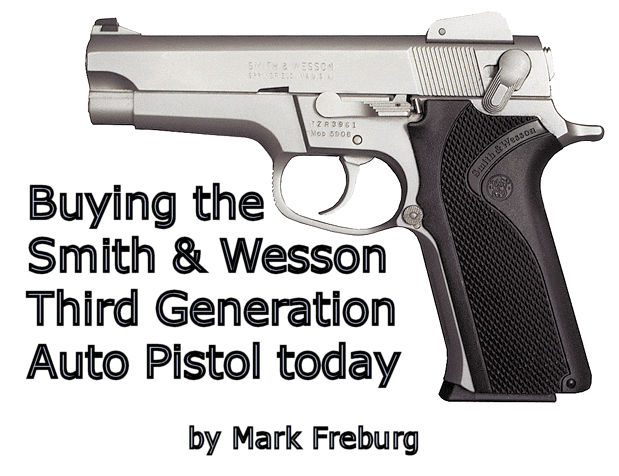
I thought I'd make a few comments about third generation Smith & Wesson DA/SA auto pistols for those interested in acquiring them. I happen to look at these often on both Gun Broker and in person whenever I see them. They show up quite often at our Ohio Gun Collectors Association shows, and less often in local gun shops, but they are by no means rare. As you probably know they were one of the top three police pistols for probably fifteen years during the DA/SA heyday. Between the Beretta92/96, SIG P226/P229/P220, and the S&W 5906 and a few of its siblings, these DA/SA autos rode in the vast majority of America's police holsters before the striker-fired polymer revolution. As such, private citizens also bought them because we always buy was the cops buy, right? And just as true, since these guns existed in huge numbers, they still exist as used pistols. And some of them are still in very nice shape, with lots of life left in them. But some are not--hence my comments here.
One very true comment about S&Ws is that Smith has been long wedded to stainless steel. As the maker of the first stainless handgun, they have always been a leader there, and they made far more stainless pistols than they did blue or alloy. Thus you'll find many more examples of say, the all-stainless 5906 and the stainless/alloy 5903 than you will the blue/alloy 5904 or (rare) blue steel 5905 variants of the otherwise identical pistol. Don't let anyone tell you that there is a premium for stainless Smiths. That's simply false. Now it is true that some models were only made in stainless, such as the 10mm variants, but those are something of an entity unto themselves due to caliber and the FBI mystique surrounding them. Most all other calibers were made in blue, alloy or stainless, with stainless predominating. Do remember I'm talking third generation here. There are stainless pistols in the second generation but they don't dominate like they do in the third generation.
Is there an advantage to stainless, here specifically? Yes, there actually is. Stainless looks good longer, and when it starts to look tatty, as our cousins across the pond say, it can be renewed if it really looks bad. Not so easy with blued and or anodized finishes. S&W has never been known for great bluing on their later semi-automatic pistols. While you'll find their earliest semi-autos were as finely blued as their revolver contemporaries, I don't believe that's the case with their later era pistols. This brings us to specific areas of concern. The first is their alloy frame pistols.
Anodizing is an electrolytic passivation process used to increase the thickness of the natural oxide layer on the surface of metal parts, in this case aluminum. Done well it's hard and last and lasts, and resists rust like no one's business. But Smith & Wesson anodized aluminum alloy frames historically show rubbed edges where the anodizing rubs off, seemingly prematurely. Perhaps these pistols have all had a hard life, and have not been cared for very well, but they look ugly, and I personally will not add a S&W pistol to my collection that shows lots of tell-tale silver edges on what should be a solid black frame. Now then, aluminum won't "rust" in the same ugly sense that steel will, though it does of course oxidize and ideally should be 100% protected. Smith & Wesson gets a poor grade from me for their anodizing over the years, whether it is their fault or just the fact that I've seen way too many bruised aluminum S&W frames.
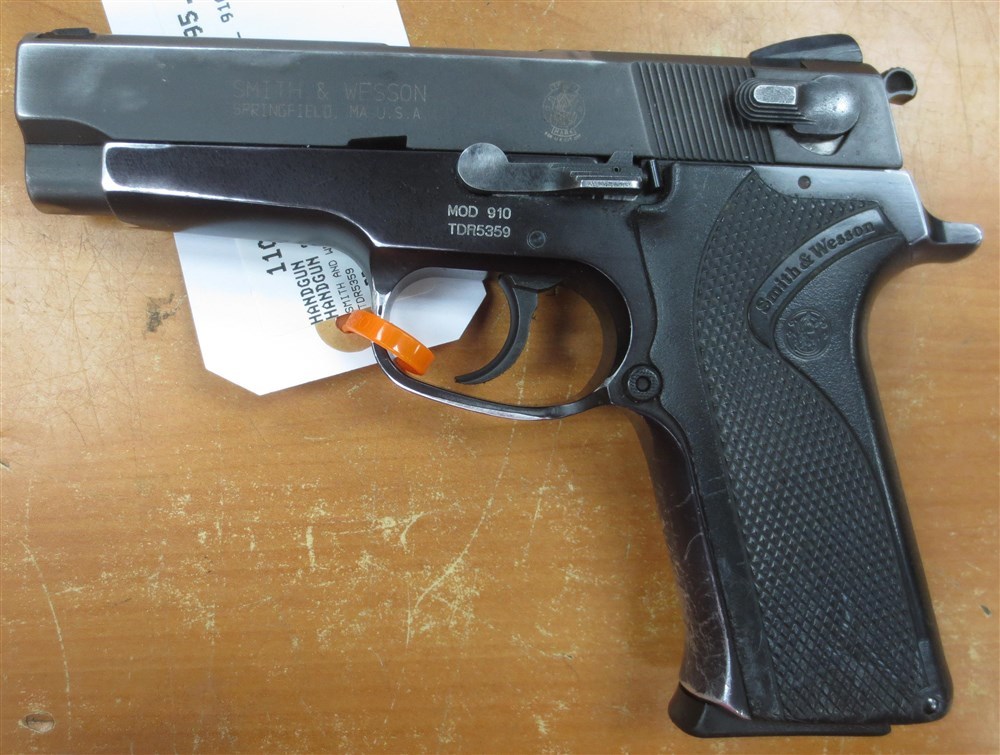
Above: a rather badly beat-up S&W Model 910, one of the third generation Value Line pistols, which are discussed below. Frankly, with all the hundreds of thousands (or more) pistols S&W made, I'll leave these beat up models for someone else to love. Don't think only blued guns can be beat up, however:
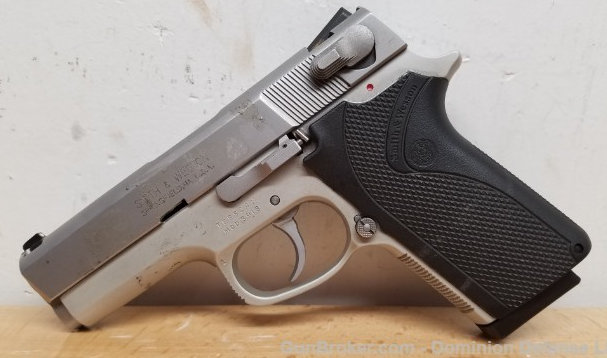
But wait, you say, several models were offered with stainless slides and alloy frames clear anodized. Anything wrong with those? Not in the sense that they will look as quite as ugly as the black anodized pistols (though see the previous photo), but gun that has damaged anodizing will be less protected whether you see the ugliness or not. If you are buying an alloy frame stainless Smith pistol, buying in person is a good idea in my opinion. But buying in person is always a good idea.
I said that the alloy frames was only one aspect favoring all-stainless pistols. The other is that, while S&W's blued slides seem to hold up better than their black-anodized alloy frames, they still get looking bad sooner than a stainless slide. And again, you simply can't touch up those hard edges on a blued gun, or the many scratches a pistol that may have been well used before it came to you may have acquired. You can touch up a stainless gun.
However, you may not want a gun that needs touching up. Still, a dark-colored gun may show its faults up better if buying online, say via auction, so those easily scratched up pistols may have an advantage there. You decide. I prefer to buy guns that look good, and leave the ratty "bargains" to others. By the way, don't get the idea that S&W finishes are exceedingly fragile--you and I are unlikely to cause any undo wear. But the average careless cop or citizen who just doesn't treat his guns with care can and has caused this sort of damage. Be aware.
Hey, how about a nice-looking pistol? Used, but clean: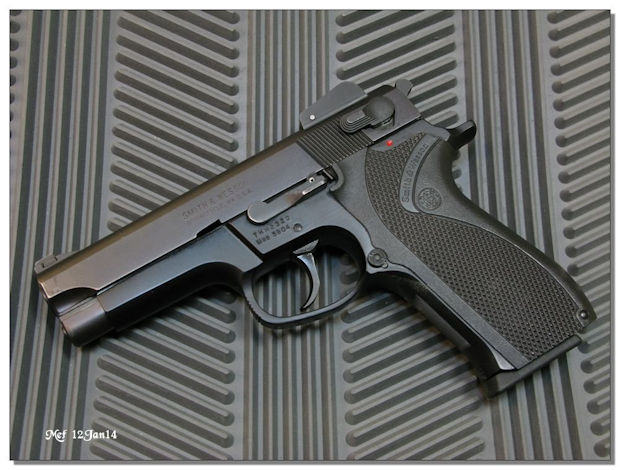
Above: Careful shopping will still turn up used blued/alloy S&Ws that despite my comments do not show excessive bluing or anodizing wear. These guns are, depending on the models of course, very light in the hand, as is this Model 5904, which is easy handling versus its heavy, stainless 5906 brother.
What are the guns to buy and the guns to avoid? Generally all the third generation guns, identified by a four digit model number, are great guns. But I'll point out a few areas I like to avoid. My list of guns to avoid--and I emphasize this is my list--yours should be based on your tastes--includes the AIP line, the Value Line, and guns without original Delrin grips. I also stick to 9mm, .45ACP, and 10mm chamberings. I've owned one .40S&W Smith pistol, a model 4053, and it was a good gun. I sold that one because I tested the DAO format for about 10 months and decided it was lacking--though S&W did it better than Beretta or anyone else converting their traditional DA/SA guns to DAO at the time (early 1990s). It was just a non-starter as action types went. (If learning about action types and how we got to where we are today interests you, see our article Making Sense at the Gun Counter where I discuss different defensive pistol types). I've gone through perhaps eight or nine other .40S&W pistols and have dropped it from my cartridges of interest, so today only those three get my attention. If you like any or all of the four mentioned, by all means consider them, as all were very good pistols done well by Smith & Wesson.
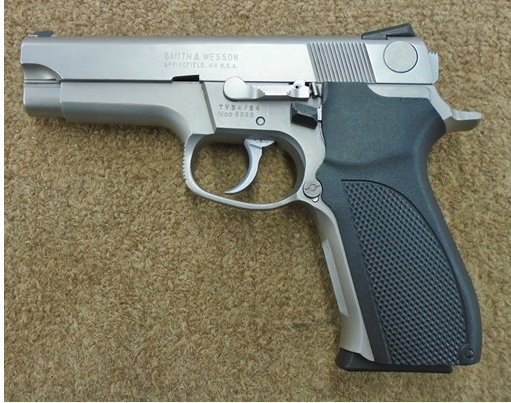 I also stick to traditional DA pistols--first shot DA, subsequent shots SA. There are still quite a few DAOs lurking out there, and if you haven't tried one, it certainly is worth trying to see for yourself how Smith approached that "problem" at the time. I also avoid the models that had SIG-like, frame-mounted decockers. You can usually ID these models as the third number in the model number will be a "2." For example, "Model 5926," one of which is shown at right.
I also stick to traditional DA pistols--first shot DA, subsequent shots SA. There are still quite a few DAOs lurking out there, and if you haven't tried one, it certainly is worth trying to see for yourself how Smith approached that "problem" at the time. I also avoid the models that had SIG-like, frame-mounted decockers. You can usually ID these models as the third number in the model number will be a "2." For example, "Model 5926," one of which is shown at right.
These somewhat unloved models were a result of S&W's involvement with the FBI, who at the time was enamored with the 10mm cartridge and wanted a bastardized version of S&W's large frame .45, only in 10mm Auto. One of their several changes to Smith & Wessons very successful pistol, besides the change to 10mm was changing the slide-mounted decocker to a frame-style, as seen on SIG-SAUER pistols, and dropping a safety altogether. ![]() Was this part of the problem with the inability to decock some cocked, loaded pistols the FBI experienced in the field? One never knows, but this doesn't happen with unaltered S&W pistols. Some claim it was FBI insistence on S&W fiddling with the trigger. My take is that the whole FBI experience was a fiasco, and one should ignore it and just get back to enjoying the many trouble-free Smith & Wesson pistols with the standard slide-mounted decocker. Or, if you like, the DAO models.
Was this part of the problem with the inability to decock some cocked, loaded pistols the FBI experienced in the field? One never knows, but this doesn't happen with unaltered S&W pistols. Some claim it was FBI insistence on S&W fiddling with the trigger. My take is that the whole FBI experience was a fiasco, and one should ignore it and just get back to enjoying the many trouble-free Smith & Wesson pistols with the standard slide-mounted decocker. Or, if you like, the DAO models.
Let's get on to details.
Do be aware that later in the run of this generation, as the costs started climbing, sales started slowing down, and the polymer pistols were cutting into profit, S&W came up with a way to recoup some of the lower end of the market. They called it the Value Line. (I've heard it called the "American Pride" line as well. Not sure where that came from.) What S&W did was to take most of their popular models in 9mm, .40S&W, and .45ACP in full-size and compact, single and double stack variants, to even include a 10 round double stack for communist states who couldn't accept the 15 round version, and they cut corners on them. Instead of the finely machined slides requiring multiple machining cuts (note an S&W slide has always resembled a 1911 slide), they made them cheaper looking, like a SIG slide, simply hexagonal in shape. They dropped the expensive-to-license Novak sights and replaced them with cheap but functional generic sights. They dropped the ambidextrous safety/decockers (bi-lateral for you who can't wrap your mind around "ambidextrous"). Perhaps worst, the finishes on the blued guns were cheaper than ever, and the finishes tended to wear off a little as you walked to your car with your new gun, and by the time you got home the finish was nearly worn off completely...okay, I'm joking. A little. ![]() All that said, these Value Line pistols were still third generation pistols internally, and despite the cheapening, they were solidly S&W pistols with all the functionality and reliability of this series of pistols.
All that said, these Value Line pistols were still third generation pistols internally, and despite the cheapening, they were solidly S&W pistols with all the functionality and reliability of this series of pistols.
While these changes are obvious to an S&W auto fan, they still made it easy for those new to the game--they have them three digit model numbers instead of the four of other third generation guns. Now there is some possibility of mixing up these three digit model number Value Line third generation pistols, with the three digit model number second generation pistols, but one clear difference that will differentiate them for you is that the Value Line still used the one-piece, wrap-around Delrin (a type of polymer related to nylon) grip of the rest of the third generation used. ALL first and second generation models used two-piece, NON-wrap-around stock panels--like a 1911, for example.
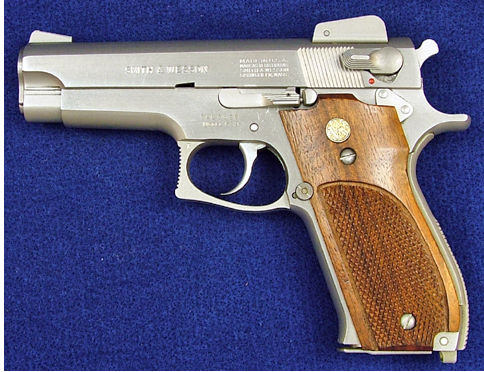
Note the wood stock panels on the pistol on the blue background? This is a second generation Model 639, successor to the original S&W model 39, a single stack 9mm. This is a good pistol, and may be something you are interested in, though second generation pistols are a story for another day. But I show it here to give you a clear picture that this is a second generation pistol, NOT a third generation Value Line gun. The three digit model number in this case means second generation. A seasoned S&W fan will note the graceful lines of the Model 639, and not confuse it with a Value Line model shown next, below. Value line pistols were almost always blue as well--though a few Value Line models did ultimately appear in stainless, with a clear anodized or black anodized frame, and with an "S" appended to their model numbers. Compare this Model 908 with the standard third generation pistol from whence it came, the Model 3913 shown just below it.
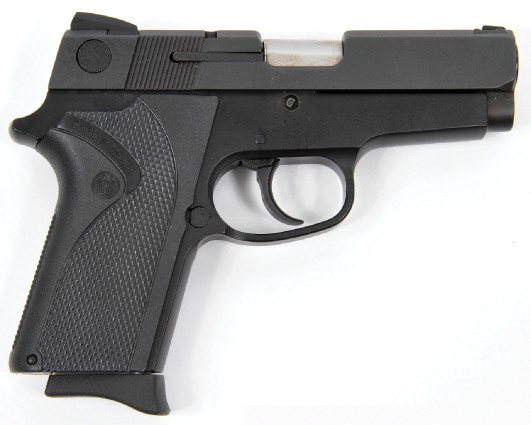
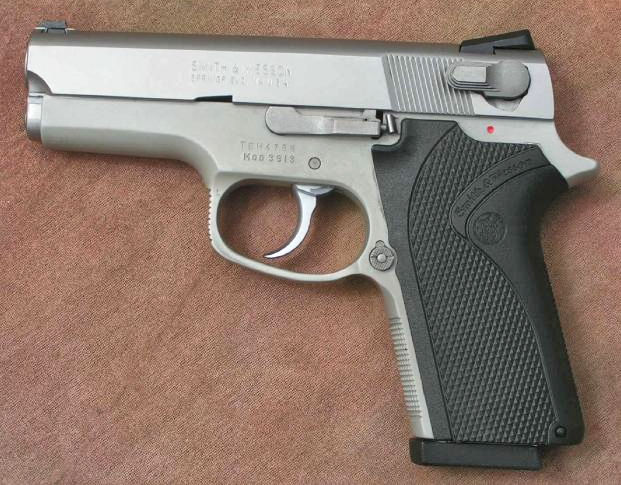
Above (both photos): Note lack of ambidextrous safety on Model 908, more elegant sculpting of 3913 slide. And while the 908 looks good in this photo, it seems that experts agree that those finishes were cheap indeed, and truly wore prematurely.
So, are used Value Line pistols a good buy? Maybe, but ONLY if they are significantly less money than a standard third generation equivalent model. Perhaps as late as five years ago I would say look at the Value Line if money is tight and you wanted a DA/SA carry gun, but DA/SA guns are losing favor and collectors are perhaps slightly less interested in Smith third generation guns, so prices are coming down right now. So if you are shopping around because you like them, I suggest you ignore the Value Line unless it is simply being given away. For me, the pistol would have to be mint and $200 cheaper than it's standard model equivalent.
I mentioned the Delrin wrap-around grips above. S&W some years back announced a decision to stop supporting the third gen pistols. That's okay, you'll rarely need parts, springs and mags are available, and various parts if they are needed can easily be had from Numrich Gun Parts Corp. However--too many people threw away those original Delrin grips, and replaced them with overly fat, rubber Hogues. Also, some of the large frame and double stack pistols came with flat or arched backstrap version of the Delrin grips, and you may wish you had the one your used pistol didn't come with. Unfortunately you can't just call S&W and ask for a new set, like I did when I bought my last large frame S&W auto 10-15 years ago. Okay--if you have monstrously large hands and the Hogues fit you, all to the good, but if not, you might shop around and try to acquire a pistol that has the original grips. They are not easy to find anymore. About Delrin, while you'll find they often look a bit worn, the grips come off very simply, and a toothbrush and some liquid dish soap will usually make them look like new again. Unless the previous owner really abused them by actually wearing the molded-in checkering down to smooth Delrin, and it takes a lot to do so, I wouldn't be too worried about minor marks and dirt.
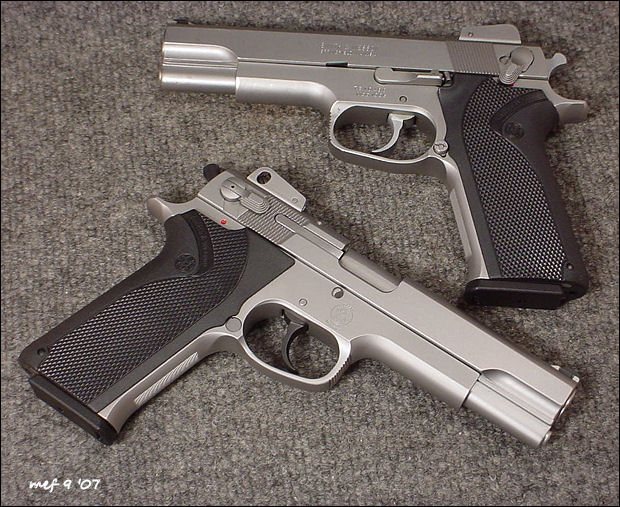
Above: two similar pistols. The Model 4506-1 in front was like new and had perfect appearing grips. The Model 1006 in back was not nearly as nice looking and the grips looked worse. But some cleaning as mentioned in the text left the grips on the 1006 looking almost as nice the ones on the 4506. By the way, also note these pistols have a "straight" backstrap. One some models an "arched" version was available, and both could be had. Something to be aware of.
Night sights on any third gen S&W pistol are almost for sure going to be dead. The very latest of these third generation pistols were the TSW custom shop models and they barely date into this century, so you can figure if the pistol has night sights they will be white circles with useless black circles in the middle. I actually have one like this, the model 1006 from the photo above, and as a range model it doesn't bother me. To change out S&W adjustable rear sights is way more trouble than I ever wanted to bother with, so I left them and I can use the white circles. Maybe I'll change them some day if I can find a replacement set of white dots, or perhaps I'll paint over the vials. ![]()
![]() But be aware that you simply are not going to get working night sights on a pistol from this era. Of course, night sights are over-rated.
But be aware that you simply are not going to get working night sights on a pistol from this era. Of course, night sights are over-rated.
That said, most of these guns had fixed sights, and except for the first two years, they are going to have excellent, licensed Novak fixed sights with three white dots. Those are likely to be in perfect condition, and of course if a dot is ever damaged that is the work of mere moments to fix.
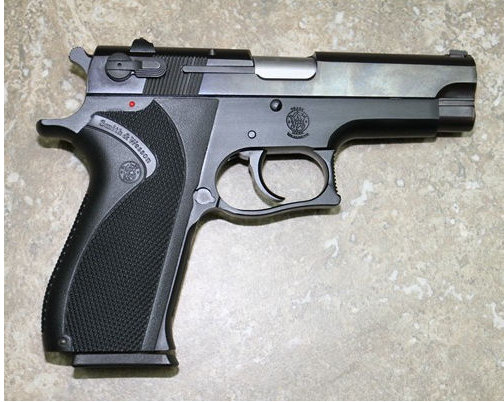 Regarding those first two years of production, those were the AIP years, the Auto Improvement Program guns, and those pistols are easily identified by squared off trigger guards with a hook for the offhand fore-finger. Americans went through a phase during the 1980s when we thought it was a good idea to shoot with our finger hooked around the trigger guard. Only took a few years to disavow us of that notion, while the Europeans have been building guns like that for DECADES upon DECADES. Then again, have you ever held a European rifle stock to your shoulder?
Regarding those first two years of production, those were the AIP years, the Auto Improvement Program guns, and those pistols are easily identified by squared off trigger guards with a hook for the offhand fore-finger. Americans went through a phase during the 1980s when we thought it was a good idea to shoot with our finger hooked around the trigger guard. Only took a few years to disavow us of that notion, while the Europeans have been building guns like that for DECADES upon DECADES. Then again, have you ever held a European rifle stock to your shoulder?  My only personal complaint about the AIP era was that S&W built the Model 3904/06 pretty much ONLY from 1989 to 1991, the AIP era, and thus they almost ALL have that ugly trigger guard. As you can guess, I love the 3904 and would have added it to my collection years ago, because it was the ultimate evolution of the Model 39, a full-size single-stack 9mm. As it is, I think but don't know that perhaps a few 3904/06 pistols were shipped after S&W dropped the Euro-trigger guard, but I've never seen one that I recall.
My only personal complaint about the AIP era was that S&W built the Model 3904/06 pretty much ONLY from 1989 to 1991, the AIP era, and thus they almost ALL have that ugly trigger guard. As you can guess, I love the 3904 and would have added it to my collection years ago, because it was the ultimate evolution of the Model 39, a full-size single-stack 9mm. As it is, I think but don't know that perhaps a few 3904/06 pistols were shipped after S&W dropped the Euro-trigger guard, but I've never seen one that I recall.
One other issue with the AIP pistols is that they feature rather ho-hum sights. Not bad but not the excellent Novak's that would shortly grace the S&W third generation line.
Not much else to say about buying these guns, except that right now, the last six months or so as I write this (early 2019), prices have been dropping pretty steadily, and pistols that have been among the best sellers in the third generation line, darlings like the 3913, which was going for $500-$600 easily a couple years ago, is selling for $400 or not much more now, in fine condition. And that is probably the best selling main line S&W model there is. By main line I simply mean not one of the collectibles, like the 10mm pistols, or others that may have only been built in limited numbers.
S&W auto pistols are wonderful guns, fun to shoot, fun to collect (though I' m no collector), and still make very good self-defense guns for those who prefer the DA/SA style action. If you have concerns about the DA to SA trigger pull, it is not a big deal, and can be easily mastered. Don't let the modern striker-fired shooters tell you it is a big problem. Here's an article covering how to shoot DA pistols successfully: How to Shoot a Double-Action Trigger.
Enjoy the quest. There are lots of great guns out there.
If you are a real S&W auto pistol collector and I've screwed up this article in any way, please let me know via a message on our wonderful forum message board.


MarkFreburg
Uploaded: 2/14/2019

